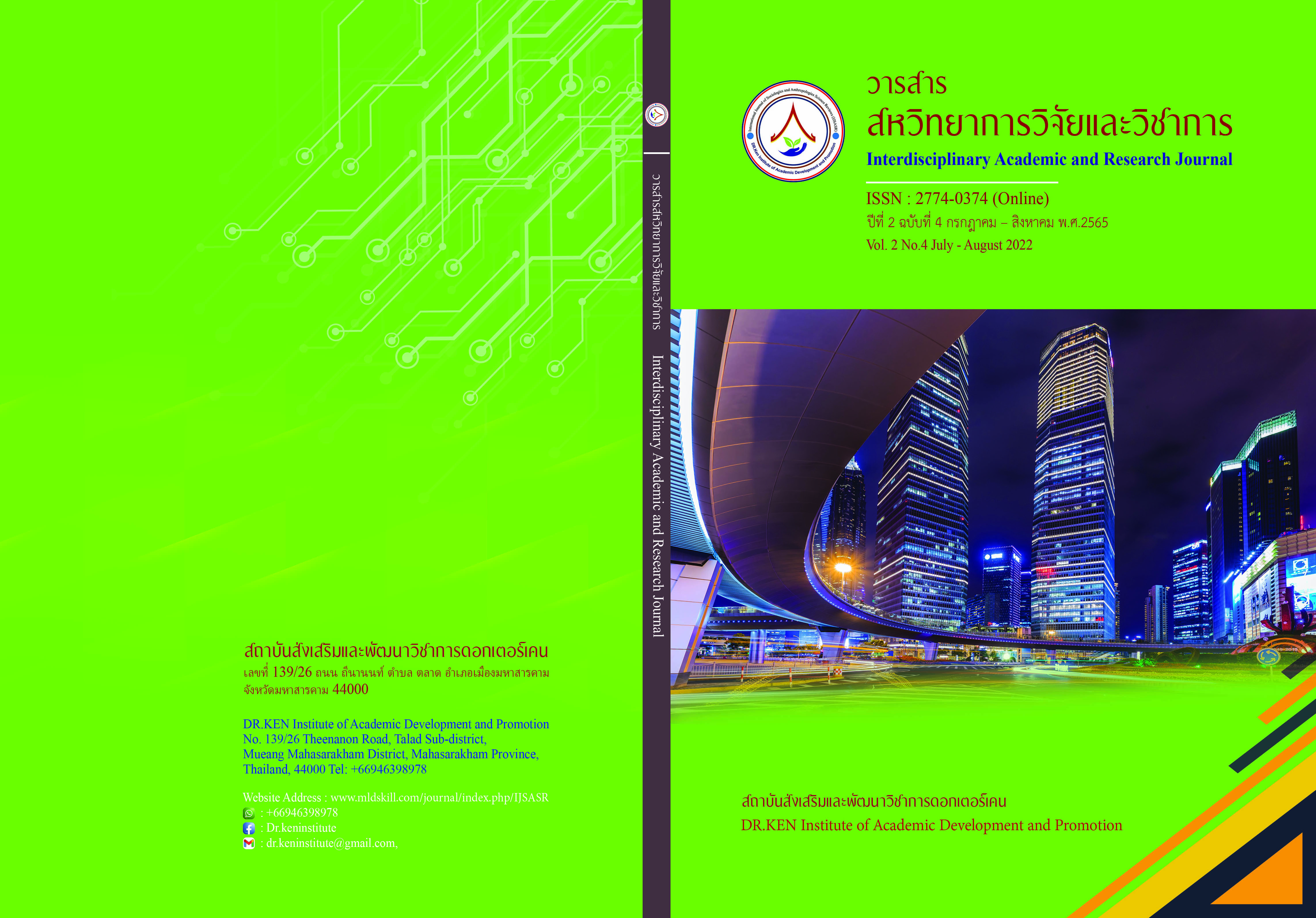Process of Calming the Mind to Increase Happiness and Reduce Suffering due to Disaster of Covid 19 (COVID 19) According to Buddhist Guidelines: Case Study of Ban Siew Noi Area, Ban Lao Subdistrict, Chaiyaphum Province
DOI:
https://doi.org/10.14456/iarj.2022.45Keywords:
Mind Calming; , Happiness; , Suffering, , Buddhism; , Disaster of COVID 19Abstract
Well-being is an abstract definition that attempts to find meaning among those who study the philosophy of happiness, which interprets it in many dimensions and evaluates it in a symbolic form of self-worth. However, well-being is the path of one's conduct leading to the highest goodness in human life, which consists of good conduct, wisdom, knowledge, and an abundance of virtue. Therefore, this study's objectives are 1) to study the causes of suffering according to the 4 Noble Truths; 2) to study the Dharma teachings for cessation of suffering and increase happiness according to Buddhism, and 3) to convey the process of calming the mind in cessation of suffering and increasing happiness. Sustainable happiness according to Buddhism. It is mixed-method research using quantitative research methods from data collection in the population of Ban Siew Noi, Ban Lao Sub-district, Mueang Chaiyaphum District. Chaiyaphum Province consisted of 366 people by simple random sampling. and distribute questionnaires as per convenience. Qualitative research By collecting information from a group of key informants, a group of village leaders, namely the village headman, and the village headman's assistant. Public Health Volunteers (MCU), etc., by interviewing and setting up a focus group or a small group discussion. The results showed that most of the people in the community live and live simply. Vegetables are planted in the vegetable garden and local food is available for cooking. As a result, people do not need to struggle and increase their expenses even more. The simple lifestyle made the rural people happy. to maintain good physical health Influencing each other, physically healthy people will result in a strong and cheerful spirit. Staying healthy includes eating the right food, enough rest keeping the body clean as well as adequate exercise being able to choose to do what you enjoy or to satisfy your job, finding ways to work happily, and setting multiple goals within socially acceptable limits. according to their abilities and can see the way to success. The cause of suffering according to the Four Noble Truths of the people in the area was caused by the people's desire for happiness. This was the need for physical happiness, followed by mental happiness. social happiness and intellectual happiness, respectively. The way of life is the middle way, the 8th Path, the 4 Noble Truths, the Fourth Bench, the Benchadharm, and the Laity Dharma 4. When something affects the mind, one will adhere to the Five Precepts, live life without harming all beings, cultivate mindfulness, maintain the precepts, and practice oneself so that there are no problems with children. and help their children accordingly.
References
กรกช วนกรกุล, (2560). ดัชนีชี้วัดความอยู่ดีมีสุข. วารสารวิชาการ มหาวิทยาลัยหอการค้าไทย มนุษยศาสตร์และสังคมศาสตร์, 37 (3), 162-178.
ชัชฎาภรณ์ อย่เย็นเป็นสุข. (2561). การศึกษาพุทธปรัชญาเพื่อการพัฒนาที่ยั่งยืน. วิทยานิพนธ์ศิลปะศาสตรมหาบัณฑิต (การเมืองและยุทธศาสตร์การพัฒนา) สถาบันบัณฑิตพัฒนบริหารศาสตร์
ไชยฤทธิ์ อนุชิตวรวงศ์, (2555). แนวคิดความอยู่ดีมีสุขของไทย. เอกสารประกอบการเรียนรู้ นักศึกษา วปอ. หลักสูตร วปอ. รุ่นที่ 60.
ธันย์นิชา วิโรจน์รุจน์. (2563). ความมั่นคงทางจิตใจ : ลดความเสี่ยงช่วยแก้ปัญหาสังคม. วารสารมหาจุฬาวิชาการ, 5 (2), 141-150.
บุญชม ศรีสะอาด. (2545). การวิจัยเบื้องต้น. พิมพ์ครั้งที่ 7. กรุงเทพฯ : สุวีริยาสาส
ประเวศ วะสี, (2549). การพัฒนาระบบสุขภาพชุมชน สุขภาวะชุมชนเป็นรากฐานของสุขภาวะทั้งมวล. สำนักงานหลักประกันสุขภาพแห่งชาติ. พิมพ์ครั้งที่ 1 กรุงเทพ.
พรรณทิพา ชเนศร์. (2560). พุทธจิตวิทยากับการส่งเสริมการมีอัตลักษณ์ของแพทย์แผนไทยด้วยหลักธรรม “พรหมวิหาร 4. วารสารวิชาการ สถาบันพัฒนาพระวิทยากร. 1 (2), 29-43
พระครูสมุห์วรวิทย์ ผาสุโก และพระสุนทรกิจโกศล, (2562). ทุกข์และการดับทุกข์ในคัมภีร์อรรถกถาธรรมบท. วารสารมหาจุฬานาครทรรศน์, 6 (9), 4166-4183.
พระมหาสุทติย์ อาภากโร และคณะ. (2556). การสร้างและพัฒนาตัวชี้วัดความสุขของประชาชนตามหลักคำสอนของพระพุทธศาสนา. กรุงเทพฯ : ศูนย์สร้างเสริมสุขภาวะองค์กร สถาบันวิจัยพุทธศาสตร์ มหาวิทยาลัยมหาจุฬาลงกรณราชวิทยาลัย.
สำนักงานทะเบียนราษฎร์อำเภอเมืองชัยภูมิ. (2564). ข้อมูลจำนวนประชากรอำเภอเมือง จังหวัดชัยภูมิ. ชัยภูมิ : สำนักงานทะเบียนราษฎร์อำเภอเมืองชัยภูมิ
อนุรุธ ว่องวานิช. (2560). แนวทางการพัฒนา และเสริมสร้างศักยภาพเยาวชนไทยด้วยหลักพุทธธรรม ในยุค Thailand 4.0. เอกสารประกอบการเรียนหลักสูตรการป้องกันราชอาณาจักร รุ่นที่ 60 วิทยาลัยป้องกันราชอาณาจักร ประจำปีการศึกษา พุทธศักราช 2560 – 2561
อุ่นเอื้อ สิงห์คำ และน้องเล็ก คุณวราดิศัย, (2557). กระบวนการและผลของการสร้างเสริมสุขภาวะองค์รวมวิถีพุทธ. วารสารสมาคมวิจัย, 19 (1), 152-172.
Best, John W. (1977). Research in Education. 3rd edition. New Jersey: Prentice-Hall.
Cronbach, L. J. (1970). Essentials of Psychological Testing. 3rd Edition. New York: Harper and Row.
Yamane, T..(1973 ). Statistics: An Introductory Analysis. 3rd Edition. New York. Harper and Row. Publications.
Downloads
Published
How to Cite
Issue
Section
License
Copyright (c) 2022 Chukiat Phalapol

This work is licensed under a Creative Commons Attribution-NonCommercial-NoDerivatives 4.0 International License.
Copyright on any article in the Interdisciplinary Academic and Research Journal is retained by the author(s) under the under the Creative Commons Attribution-NonCommercial-NoDerivatives 4.0 International License. Permission to use text, content, images, etc. of publication. Any user to read, download, copy, distribute, print, search, or link to the full texts of articles, crawl them for indexing, pass them as data to software, or use them for any other lawful purpose. But do not use it for commercial use or with the intent to benefit any business.
















.png)


